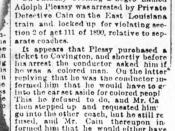In 1986, the Plessy v. Ferguson Supreme Court case established that there could be separate but
equal facilities for blacks and whites, giving support to Jim Crow laws. The Supreme Court did
not begin to reverse Plessy until the Brown v. Board of Education Supreme Court case 58 years
later, which established that segregating blacks and whites was unconstitutional and that separate
could never be equal.
After the period of reconstruction following the Civil War, many states in the south and
other regions of the country passed laws that discriminated against African-Americans. These
laws ranged from restrictions on voting to requirements that blacks and whites use separate
facilities and attend separate schools.
On June 7, 1892, Homer A. Plessy, a man who was one-eighth black and seven-eighths
white, bought a train ticket to travel from New Orleans to Covington, Louisiana. Under
Louisiana law, he was considered black and was required to ride in the "colored" car.
Because
Plessy sat in the "whites only" car, he was arrested and put in jail in New Orleans
(Frost-Knappman).
Plessy faced trial for his crime of riding in a railroad car for whites only. John A.
Ferguson presided over his trial in federal district court. He was found guilty, and the Louisiana
Supreme Court upheld his conviction. Plessy then appealed to the United States Supreme Court
for an order forbidding Louisiana-in the person of Judge Ferguson-from carrying out his
conviction (Frost-Knappman).
On April 13, 1896, Plessy's lawyers argued before the U.S. Supreme Court. Their
argument was that Louisiana had violated Plessy's 14th Amendment right to equal protection
under the law (Cozzens). Attorney General Cunningham argued that the law merely made a
distinction between blacks and whites and did not necessarily treat blacks as inferiors (Cozzens).
On May 18, 1896, the court issued its decision,


